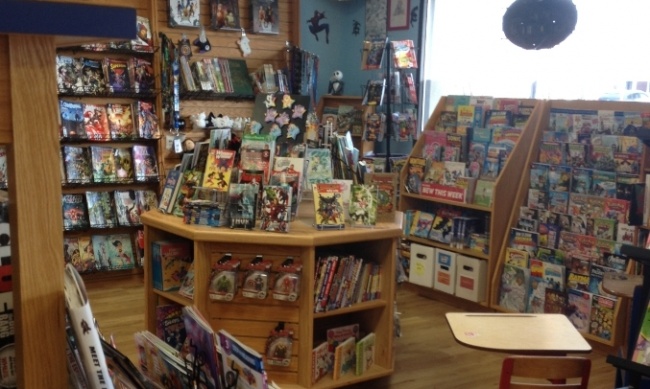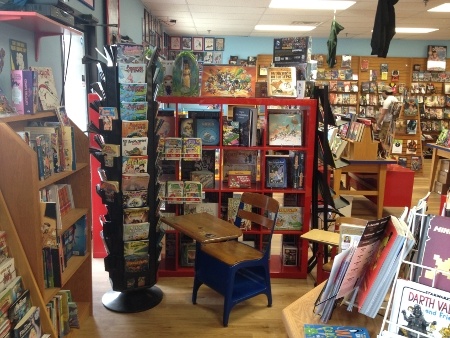As part of ICv2’s "Grow the Business with Kids" event, we spoke with Joe Murray, the owner of Captain Blue Hen Comics in Newark, Delaware, on how his store has successfully marketed to children and families. In Part 1, we talk about his display area, how the section compares financially to other parts of the store, and building a relationship with libraries. In Part 2, we talked about the ancillary benefits of the kids area, events, and the philosophy of the store layout.
[Click any image for larger view.]
How do you handle selling comics and graphic novels to kids?
Well, you don’t actually sell the comics and graphic novels to the kids; you sell their parents on the idea of the comic book and graphic novels. Usually when we’re making the pitch, you kind of have a two-pronged approach: you’re trying to find something that the kid’s going to be interested in and that the parent is enthusiastic about as well.
Also you’re trying to sell something to kids without letting them think that you’re selling them something for a kid. We’ve run into problems with, say, Star Wars Digests, if you have them in the all ages or kids section. The kids want to buy older than they are. You have to sort of work a little trickery on that and maybe have it somewhere else in the store, and kind of guide them over to it.
Our store is laid out in a fashion where the kids section is up by the front. It’s not demarcated on the floor, but it’s very easily visible, with a great deal of variety. We start working it with properties they might know from other media and then ask them questions, along with their parents, to find out what it is that they might like. But you’re always making sure that the parent is in on the equation if you’re selling to kids.
And you rack comics and graphic novels in that all ages section?
Yes, we have quite a variety of both.
How about the manga that are directed at younger readers?
We have some over there like Pokemon and Zelda, but Zelda’s kind of strange because that sells as an all ages book. We’re just as likely to sell that to an adult or teenager as to a kid.
You mentioned that issue with some other titles. Do you double rack that material in both the kids and adult sections?
Not often. Sometimes we do; there are some books we have in multiple places. You do have some kids who come in and immediately head over to stuff that’s not quite right for them, and the parents know this as well, so you’re trying to steer them in the right direction. Sometimes that does involves a little bit of sleight of hand. I don’t mean we actually misrepresent it, but it’s like convincing the kid to eat their vegetables, a little retail judo.
Within the all ages section, how do you group? Do you segment by age or use some other categorization?
It’s sometimes by theme. It’s hard because the children’s section is your hardest section to shelve and actually keep organized because you need to have more of that stuff face out than you do anywhere else in the store. Sometimes it leads to practical concerns of how much space you actually have to display the item.
I can’t say that we have a hard and fast rule about it, but we try to have a My Little Pony section, and a Bone section, and some superheroes, along with Minecraft and some others.
What about the author titles? Do you group those separate from the licensed material?
Yes, those are on a separate bookshelf, alphabetically or by title alphabetically. There are sort of two different buyers in that respect. I don’t want to say that there are the "art and literature" of kids’ books and then there is the "pop culture’ of kids" books, but there sort of is. There are two different audiences for it sometimes.
Does the square footage you devote to kids titles produce in the same way as other parts of the store in terms of revenues or gross margin?
Absolutely, yes. On our to-do list are sections of our store that we need to do some return on investment analysis, but when we do our weekly reorders there are always kids’ books in our weekly reorders. A lot of our vendors who deal in kids’ books (Abrams, Scholastic, First Second, Papercutz) are vendors that I order from directly. Given that I’m meeting their minimum order quantities, which I could not do with some other vendors, it just goes to show that I am selling enough of that stuff to merit ordering direct. So, yes, it does turn around.
Within the kids section there are certain things that are definitely money makers and then there are other sections where you’re going to sit on that for a while, but I ran recently a list of our top selling books, which would include graphic novels, not comics, and Minecraft, Frozen books and Ninjago were all in our top 50. So, Fables and Walking Dead are in there, and any one of those equals two copies of a Ninjago book, but we did move a lot of units of those. Plus we also do a lot of library sales and that’s where we usually sell more kids books than older books.
Do you have a lot of librarians coming in to shop your shelves?
They don’t actually come in so often, we’re usually providing lists to them. We deal with a lot of libraries and sell books to them to stock their shelves.
We know some retailers rely on libraries as an important part of their business, especially for kids’ titles. What’s a good way for a retailer to reach out to the librarians in their town?
Our relationship started probably 10 years ago with a librarian just over the state line. They asked us to come in and do a program for them. They had a game night and we talked about the history of comics, did a presentation and brought some costumed characters over. With that particular library they also order for four or five other libraries in their county. We helped them out and that relationship grew, and from that other librarians got involved.
A lot of the librarians who worked at that particular branch went onto other important positions within the Maryland Library Association or Delaware Library Association so we ended up doing more presentations and ordered books for them. It was a slow build; it was an overnight success that took 10 years.
Right now if you go into a lot of public libraries you’ll see that they really don’t have that many graphic novels. If you can put a few graphic novels on their shelf, just as a trial thing as an investment, they will be amazed at how fast those books turn over and disappear. The school libraries and public libraries, as soon as they put them in their own section, the section is never full because it’s always being checked out. I’ve had school libraries where their traditional fiction or nonfiction books have not turned over, individual books have not been checked out in a few years, and they’re actually just getting rid of them to make way for electronic media and graphic novels and other stuff that actually gets checked out.
It’s a very good time to be doing it. Perseverance and a pleasant smile is a place to start.
It sounds like the way you got started was that you were willing to help them out with their programming and that helped build the relationship.
It does. Even if you do not place a single book on their shelf, they are an incredibly useful resource for disseminating information because they usually have pretty good email lists. They’ve been willing to advertise some of our events as well so you reach out to a larger audience. We just donated a bunch of comics that had become a bit of an albatross in the store for space reasons to one of their bookmobiles. With our sticker and labels on it over there, now a bunch of kids who didn’t know we existed now know there’s a comic store 15 minutes away. If you just keep at that, eventually they’re going to come in.
The areas we’ve had a growth at our store has been in what we call the "family section" and library sales. The problem is, it’s a different business model than normal, where you sign on a new subscriber who might spend 40 bucks a week. You’re not going to get that same thing when you bring a new customer in for the family section. You’re not going to see them every week to drop $40. You’re going to see them maybe once every six weeks to drop $10 to $20. However, there’s going to be a wider variety, so on Saturdays, the first few hours is just all families. You need to look at the numbers slightly differently than you would for your traditional comic and graphic novel sales.
Click here for Part 2.

The Display, Section Performance, Selling to Libraries
Posted by ICv2 on May 8, 2015 @ 2:35 am CT





